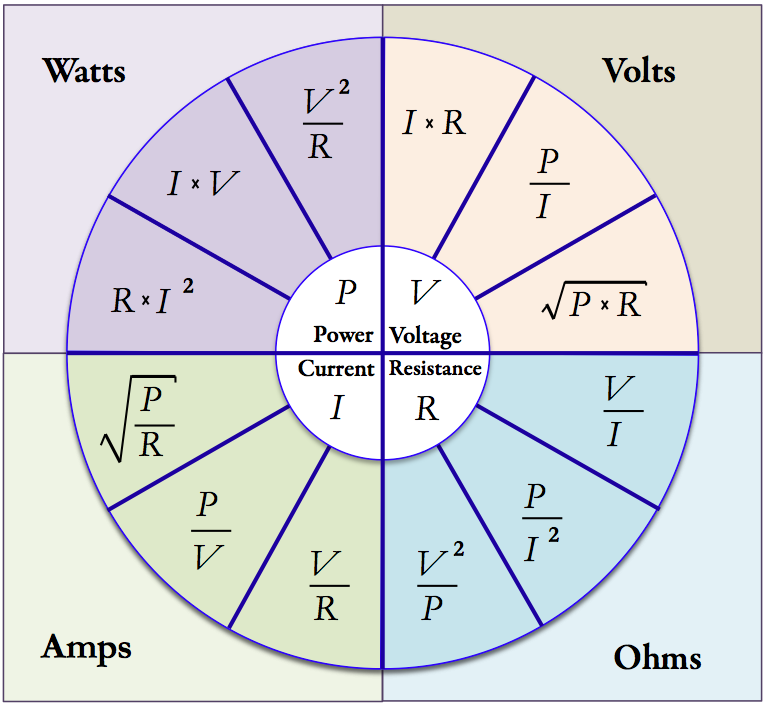The Electrical Power calculator computes the power based on Ohm's Law using electrical potential or voltage (V) and resistance (R).
INSTRUCTIONS: Choose units and enter the following:
- (V) Potential (voltage)
- (R) Resistance.
Electrical Power (P) : The calculator returns the electrical power in watts. However, this can be automatically converted to other power units via the pull-down menu.
The Math / Science
The Ohm's Law formula for power based on voltage and resistance is:
P = V² / R
where:
- P = power
- V = voltage
- R = resistance
Ohm's Law
The Ohm's Law calculator suite computes power (watts), potential (voltage), current (amps) and resistance (ohms) in relation to each other based on Ohm's Law. There is a fundamental relationship between electrical parameters: potential, current, resistance and power depicted in the graphical wheel (see wheel).

The Ohm's Law Calculator suite has automatic unit conversions for the input and output of the equations. The equations are as follows. Click on the formula for a pop-up calculator with the formula, or click on the description link for the page dedicated to that formula.
Power (watts, milliwatts, kilowatts)
- Power (P) = I • V : Computes the power (watts) as a function of current (amps) and potential (volts).
- Power (P) = R • I² : Computes the power (watts) as a function of current (amps) and resistance (ohms).
- Power (P) = V² / R: Computes the power (watts) as a function of potential (volts) and resistance (ohms).
Potential (volts, millivolts)
- Volts (V) = I • R : Computes the potential (volts) as a function of current (amps) and resistance (ohms).
- Volts (V) = P / I : Computes the potential (volts) as a function of power (watts) and current (amps).
- Volts(V) = √(P • R) : Computes the potential (volts) as a function of power (watts) and resistance (ohms).
Resistance (ohms, milliohms, kiloohms)
- Resistance (R) = V²/P : Computes the resistance (ohms) as a function of potential (volts) and power (watts).
- Resistance (R) = P / I² : Computes the resistance (ohms) as a function of power (watts) and current (amps).
- Resistance (R) = V / I : Computes the resistance (ohms) as a function of potential (volts) and current (amps).
Current (amps, milliamps, microamps, gilberts)
- Current (I) = V / R : Computes the current (amps) as a function of potential (volts) and resistance (ohms).
- Current (I) = P / V : Computes the current (amps) as a function of the power (watts) and the potential (volts).
- Current (I) = √(P/R) : Computes the current (amps) as a function of the power (watts) and the resistance (ohms).
Power is the amount of energy consumed or produced over time.
- Power is a measurement of the energy used to move vehicles (automobiles, trucks, tractors, trains, boats and airplanes).
- Power is the measurement of energy consumed by a motor and transferred to the drive or wheels.
- Power is the amount of electrical energy consumed or produced by a system over time such as the energy produced by a hydroelectric dam or energy consumed by an electrical motor.
Power Units
Power is most commonly measured in watts (W). One watt is equal to one joule per second (1 W = 1 J / 1 s). Power is also measured in horsepower (hp) where 1 horsepower equals 745.7 watts. Power is also measured in heat energy transfer as BTUs per hour (BTU/h).
Power Calculators
- Power from Change in Energy over Time
- Power based on Force and Velocity
- P = ΔE / Δt
- ΔE = P * Δt
- Δt = ΔE / P
- Power Dissipated by Friction
- Power from Force, Distance and Time
- Power from Resistance and Current
- Power from Voltage and Resistance
- Power from Current and Voltage
- Power textbook chapter (Light and Matter)